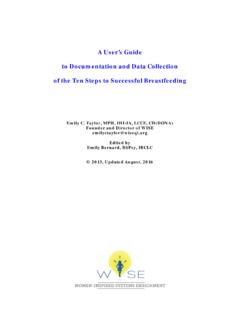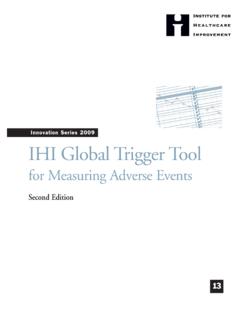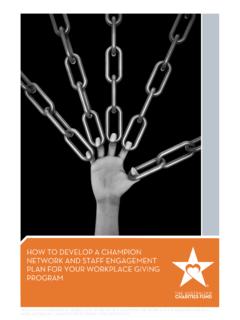Transcription of Designing a System-Wide Mortality Review Process
1 Designing a System-Wide Mortality Review Process In order to Facilitate Shared Learning from Every Death Tony Calabria, MA, CPHQ, CSSBB Rohit S. Satoskar, MD MedStar Georgetown University Hospital Matthew P Schreiber, MD, MHS, FCCP Daniel B. Jamieson, MD MedStar Washington Hospital Center Hanan Foley, MSN, RN, CPHQ Alex Montero, MD MedStar Franklin Square Medical Center MedStar Good Samaritan Hospital Andrea B. Ryan, RN, MSN, CPPS Jessica Martin, MS MedStar Harbor Hospital Frederick Finelli, MD, JD Christine A. Goeschel, ScD, MPA, RN, FAAN MedStar Montgomery Medical Center MedStar Southern Maryland Hospital Center Cherri Walrath,, MSN,, RN MedStar St St. Mary's Mary s Hospital Michelle Lundegard, BSN, RN MedStar Union Memorial Hospital Sara Parker, MD.
2 Background High-Level Workflow 1. MedStar Health is a distributed care delivery network, comprised of seven Community Acute Care Hospitals, two Academic Acute Care Hospitals, one Rehabilitation Hospital and several hundred Ambulatory Care Locations. MedStar Health is the largest healthcare provider in Maryland and the Washington, region with over 30,000 associates and 6,000 affiliated physicians. Project Aim MedStar strives to continuously improve the care that we deliver. The aim of this project is anchored in the philosophy that every death provides an opportunity to learn something new about how to improve care; whether the death is from an unanticipated event or the natural progression of illness. Project Strategy MedStar Health, in consultation with the Mayo Clinic and their physician champion, Dr.
3 Jeanne Huddleston1, and Vizient , embarked on an initiative to develop and implement a standardized System-Wide Mortality Review Process with the intent of learning from every death, sharing identified opportunities for improvement and leveraging improvement activities across the system . system leaders selected representatives from each MedStar Health Acute Care Hospital to design and implement the initiative (the advisory group). group) The advisory group developed the following tactics: Create a standardized Review Process that can be implemented across the system at each individual hospital. Agree upon a standardized Mortality Review form for data collection and application to be implemented across the system .
4 Design a Process and application for reporting opportunities for improvement at both the local hospital level and the system level. Review Process : Design a searchable Shared Learning Library/Repository for storing details of Each hospital is responsible for conducting Mortality reviews following a standardized Process implemented improvement activities from across the system . consisting of an MD/LIP Review and an RN Review . The goal of the Review Process is to identify Process and system failures [not individual provider or staff failures this is not peer Review ]. The Actions Taken reviewers and associated staff are only responsible for identifying opportunities for improvement Each acute care hospital formed a physician and nurse led multidisciplinary (OFIs) and reporting findings to hospital and system leaders by producing timely, accurate and Mortality Review Committee.
5 Membership from other disciplines varied, but actionable case summaries which will be distributed to appropriate hospital and system leaders on often included pharmacy, palliative care, clinical documentation specialists, unit a regular basis. level staff staff, etc. etc Identified opportunities for improvement are referred to hospital leadership Improvement Process : (CMO/CNO, Clinical Dept. Heads, Quality & Safety Leaders, Unit Managers, etc) Improvement activities are the responsibility of the local and system -level leaders, not the Mortality who are responsible for prioritizing and initiating improvement activities. Review Team. Case Summary Reports containing identified OFIs will be sent to local leaders and A summary dashboard updated monthly and is available to all sites for use at managers for appropriate action.
6 Senior Leadership will be responsible for prioritized OFIs and local or system level meetings. initiating improvement teams and activities. Department heads and manages may also receive Case summaries will be provided to leaders on institution specific timelines. case summaries related to their specific areas of responsibility for further Review /investigation as deemed necessary [ : peer Review ]. Anticipated Outcomes system Process : Short-Term: The intent of the system Process is to facilitate shared learning and identify improvement activities Through repeated reviews, a greater awareness of patient and family that could be applied at specific sites or across the system . Site-Level Quality Leadership will experiences with our hospitals and providers during death episodes.
7 Share specific OFIs and corrective action taken to minimize repeat occurrences. A better understanding of the utilization of the palliative care model. Recommendations for system level implementation may be determined and operationalized by Identification of previously unknown Quality and Safety Issues senior hospital and system leaders. Intermediate-Term: The beginning of ongoing monitoring for trends and patterns at the system and local levels. Identified Opportunities for Improvement*. Learning something actionable from each death. Long-Term: Creation of System-Wide communications Process for the sharing of discoveries and improvement actions taken. Include transferring system hospitals in the Review Process to expand the Review of the continuum of care to the entire patient experience within the system .
8 Using knowledge to drive change. Each anticipated death will be a better death, and any unanticipated death will not be a result of a known issue. Impact So Far Improved multidisciplinary communication within the Mortality Review Process Standardized Mortality Review Process is in place some hardwiring still needed Changed perceptions of Mortality Review from person focused [who did it] to system and Process Focused [why did it happen]. Changed perception of Mortality Review from focus only on the unit and service where the patient died but to the whole continuum of care. Identification of underutilization of Palliative Care and identification of many other opportunities for improvement. High-Level Project Timeline * Results are from a sampling p g of Mortality y cases from multiple p site from June 2016 to July y 2017.
9 Acknowledgements We would like to thank our local Mortality Review Collaborative Teams and Leaders at: MedStar Georgetown University Hospital MedStar Montgomery Medical Center MedStar Washington Hospital Center MedStar Southern Maryland Hospital Center MedStar Franklin Square Medical Center MedStar St. Mary's Hospital MedStar Good Samaritan Hospital MedStar Union Memorial Hospital MedStar Harbor Hospital 1. This project was greatly influenced by participation in the Multi-Center Collaborative to Move Beyond Mortality Review and Create the Next Generation Safety Learning system and the UHC/Vizeint Enhanced Mortality Review Collaborative. -Dr. Jeanne Huddleston, Principal Investigator 2 Vizient Inc.















